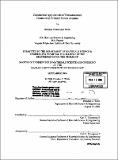Commercial applications of nanostructures created with ordered porous alumina
Author(s)
Wells, Brendan Christopher, 1979-
DownloadFull printable version (5.432Mb)
Other Contributors
Massachusetts Institute of Technology. Dept. of Materials Science and Engineering.
Advisor
Carl V. Thompson, II.
Terms of use
Metadata
Show full item recordAbstract
In the drive from microfabrication to nanofabrication, porous alumina templates may play a key role in technological evolution. Under the right processing conditions, ordered pores can grow in anodic aluminum oxide, which is a high strength, thermally and electrically insulating material. There are many potential applications for porous alumina templates, ranging from the simple fabrication of nanostructure arrays to the more complex processing of components for end-user products such as nano-integrated circuits and gas sensors. Porous alumina templates can also be processed to have long-range pore ordering on an entire twelve-inch silicon wafer, which may be of unique benefit to processes requiring such pore precision, such as parallel electron beam lithography. The high aspect ratios which can be attained through porous alumina template technology may also offer unique advantages in applications such as field-emission-based devices. As a durable high strength material, porous alumina templates are not limited by extreme process conditions, further extending the reach of their application. The vast array of applications allows the technology to be financially attractive inside business models ranging from sustaining to disruptive innovation. Porous alumina template technology has the necessary multitude and diversity of attributes to play a crucial role in the future of nanotechnology.
Description
Thesis (M. Eng.)--Massachusetts Institute of Technology, Dept. of Materials Science and Engineering, 2004. Includes bibliographical references (leaves 82-86).
Date issued
2004Department
Massachusetts Institute of Technology. Department of Materials Science and EngineeringPublisher
Massachusetts Institute of Technology
Keywords
Materials Science and Engineering.